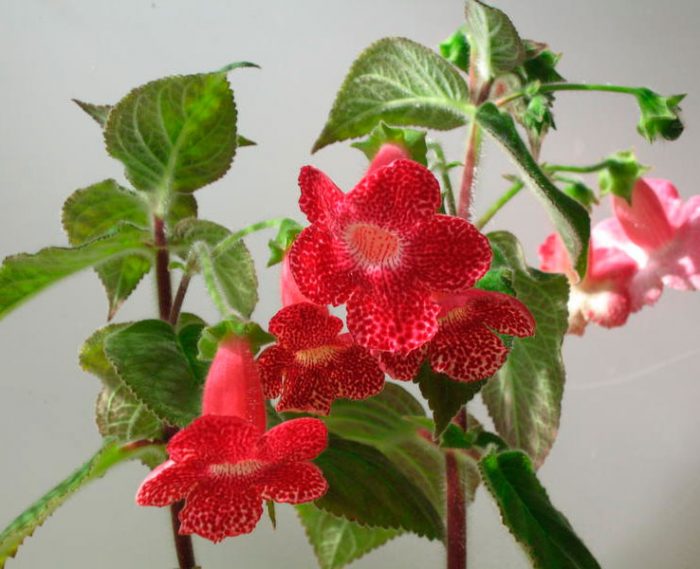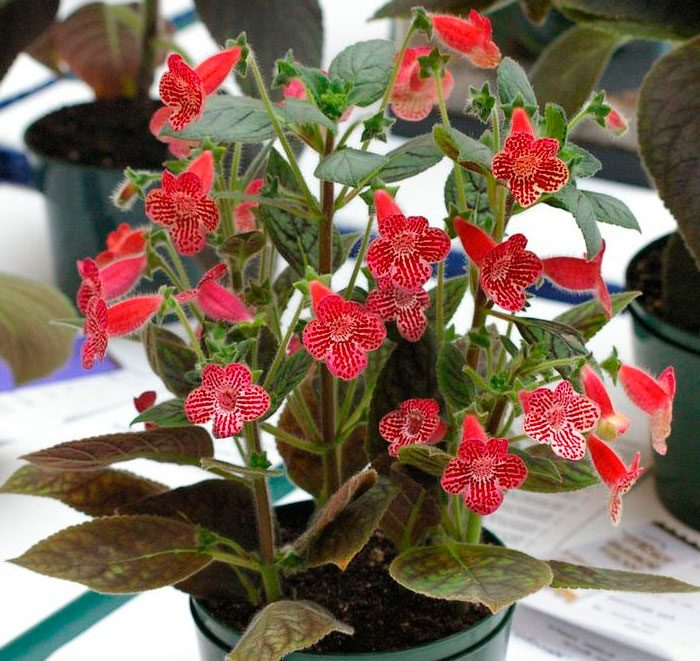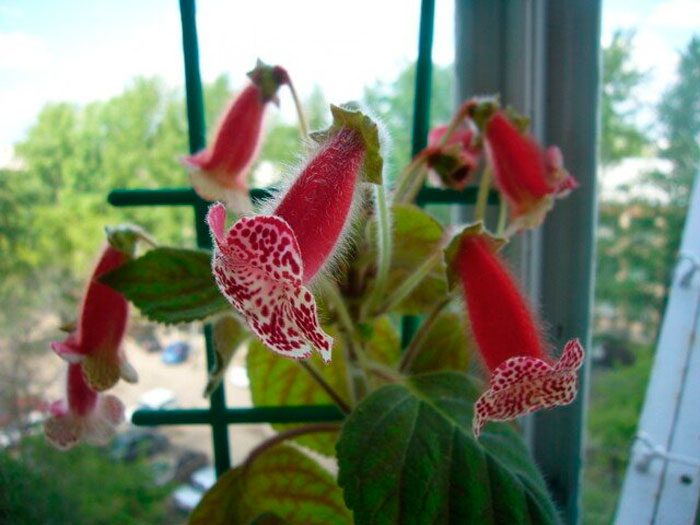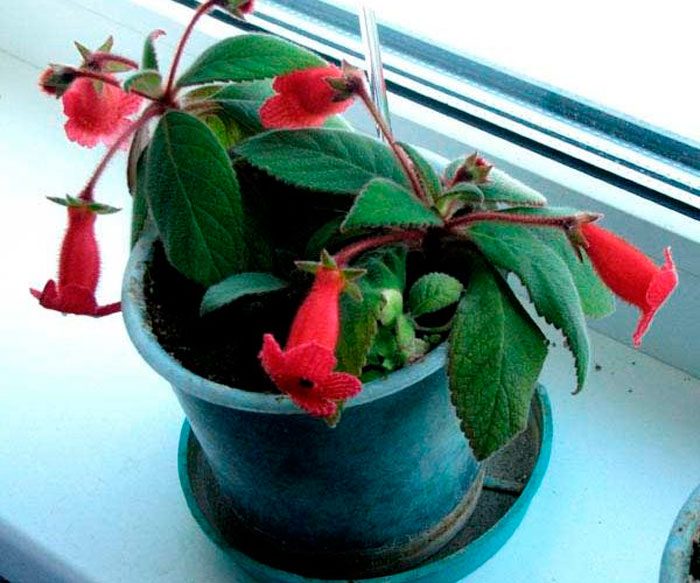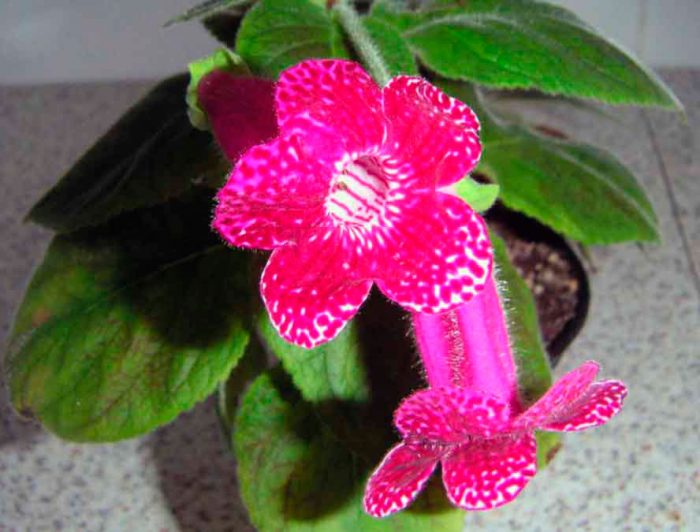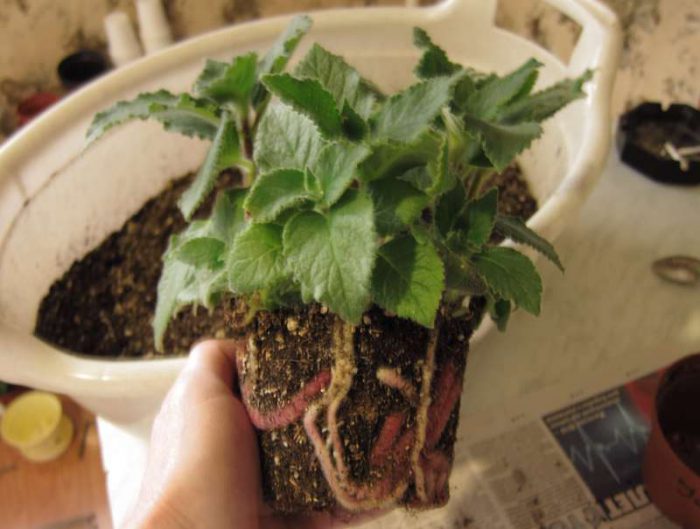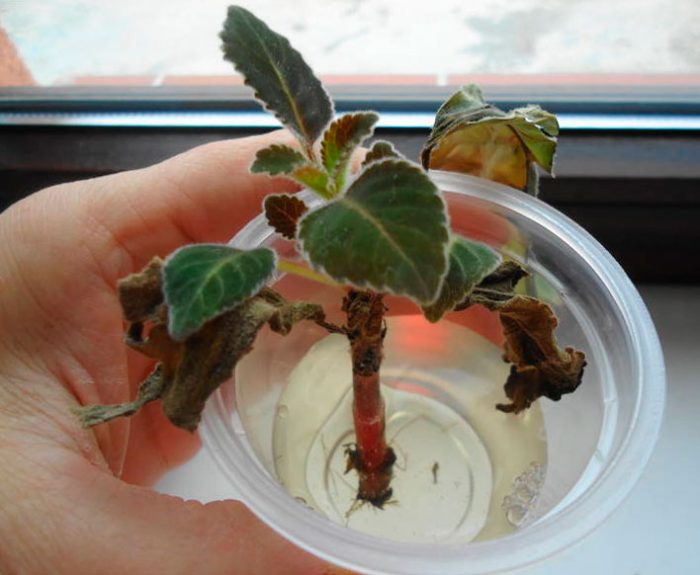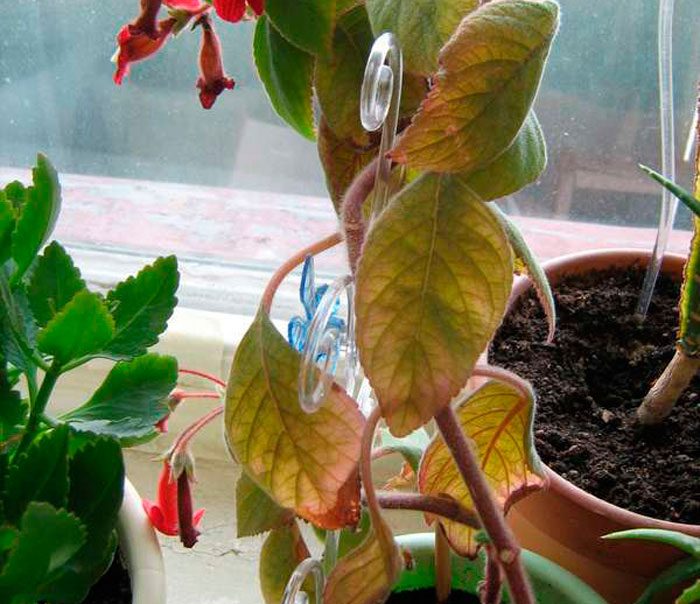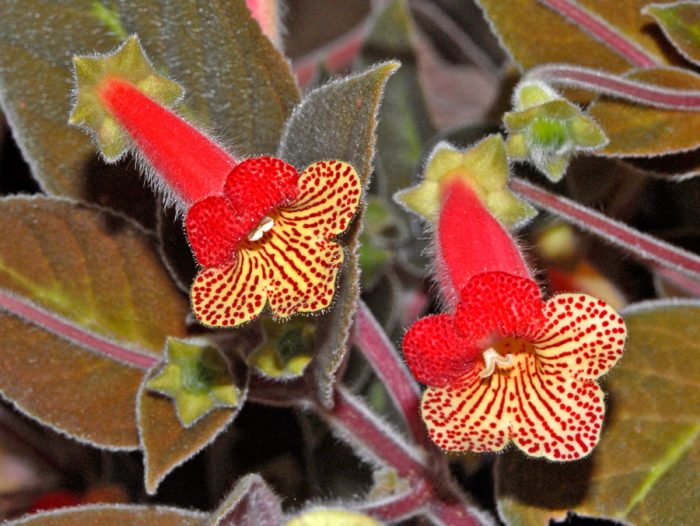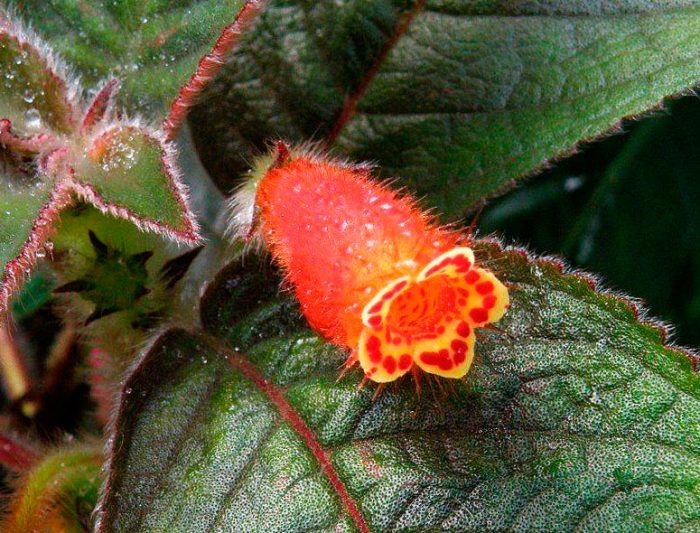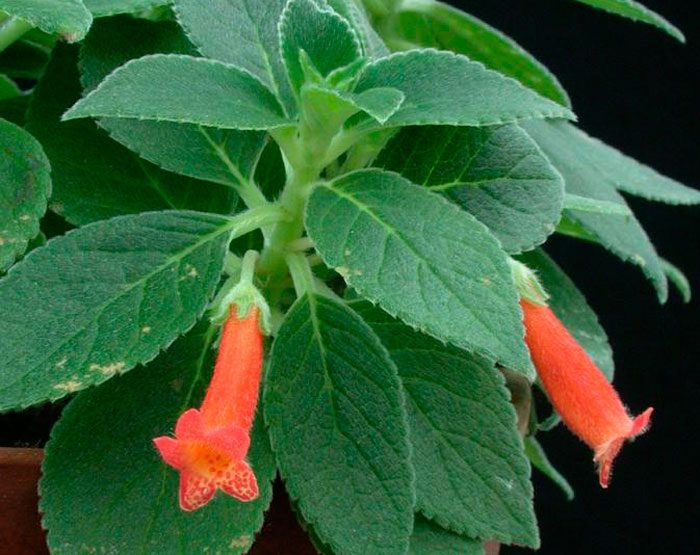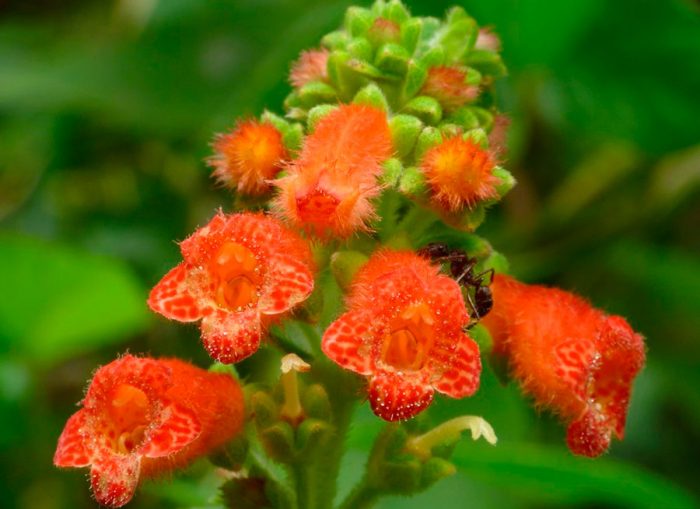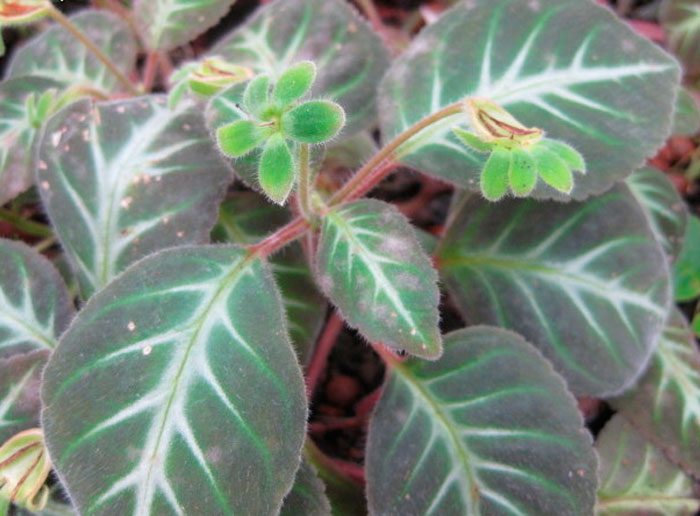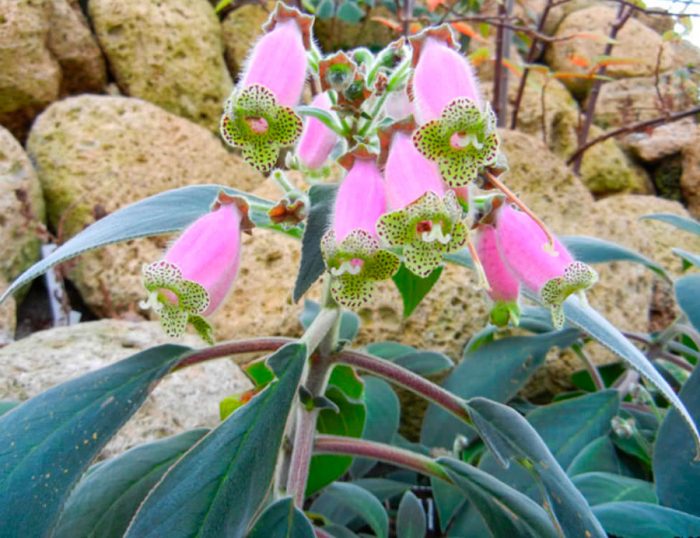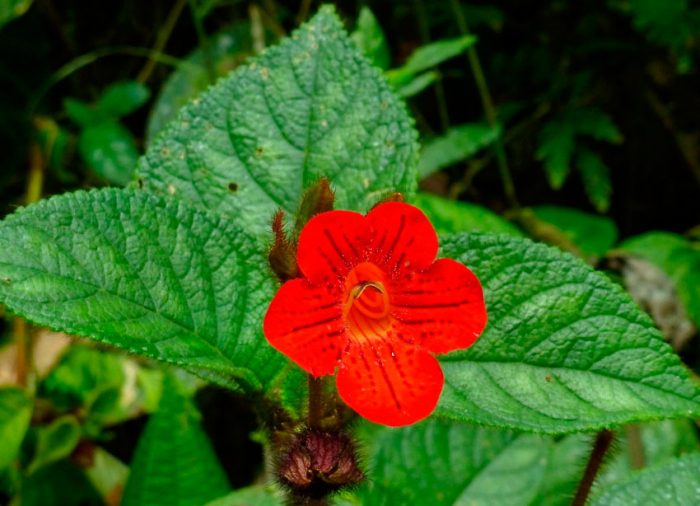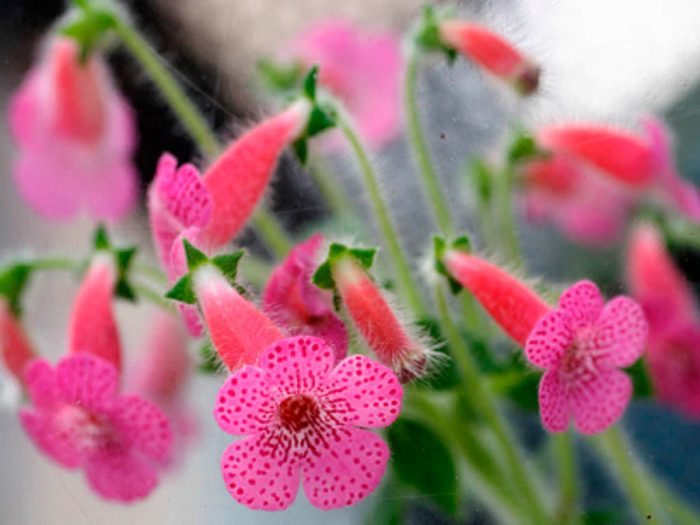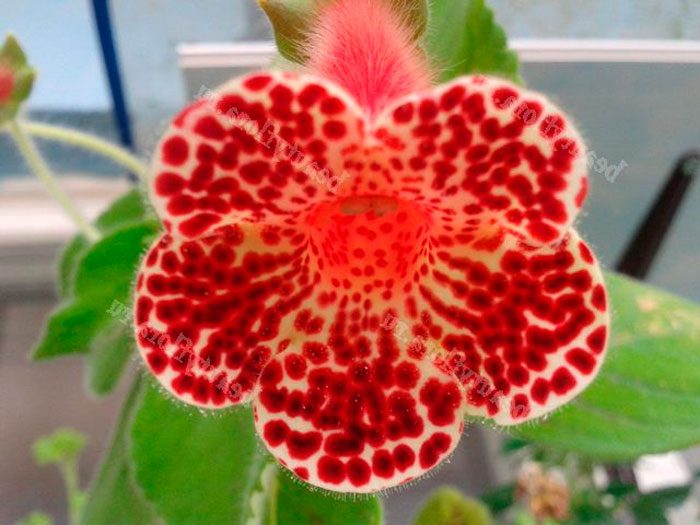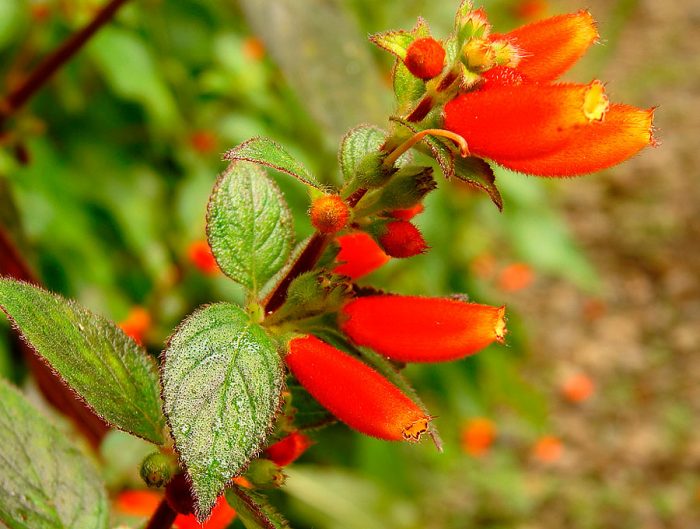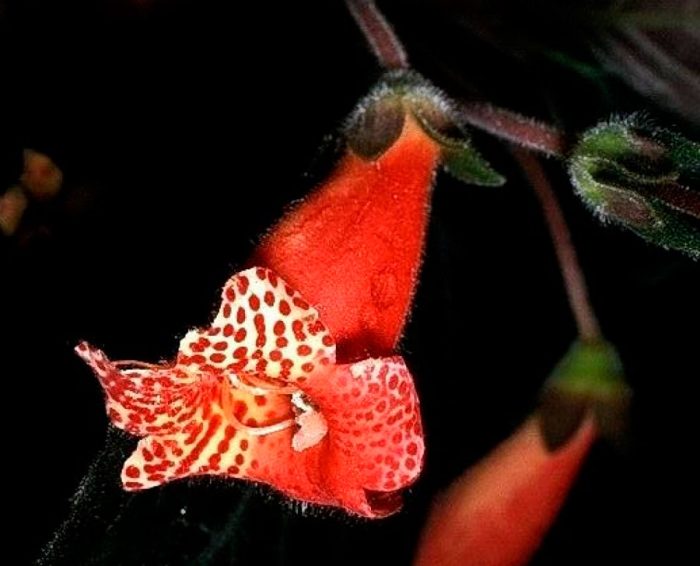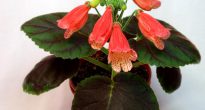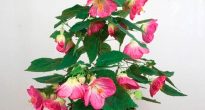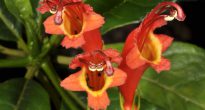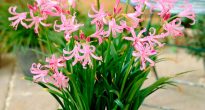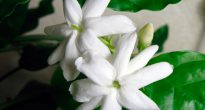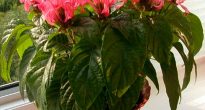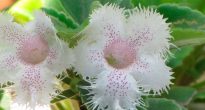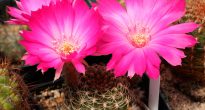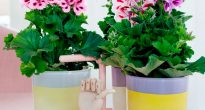The genus of plants Koleria is a representative of the Gesneriev family, it includes about 65 species. In nature, this plant can be found from Mexico to Central America, and also in Colombia and on the island of Trinidad. The name of this plant was given in honor of Michael Kohler, who lived in Zurich in the 19th century and was a famous teacher. Representatives of this genus are notable for their low demands on air humidity and temperature, and therefore it is much easier to grow them in comparison with other plants included in the Gesnerievye family.
Coleria is a perennial herb or shrub. The root-tuber of such a plant is scaly. Opposite petioled leaf plates, elongated in length, have an ovoid shape. On the surface of the leaves there is a dense covering, consisting of pile, their length is about 15 centimeters, and their width is about 8 centimeters. Some species have red veins on the surface of the dark green foliage, while others have a dark olive plate and a light colored central vein. The foliage can be glossy and ribbed, or the plates are covered with a pile of red or white. In hybrids, foliage color is silver or bronze. When grown indoors, this plant has a lush flowering. On the axillary peduncle, 1-3 flowers grow. The size of the corolla tube is about 50 mm, it is slightly widened downwards, and narrowed towards the pharynx. Corollas are bell-shaped. The wide-open pharynx has five obtuse lobes, on their surface there are many spots, dots and strokes. In natural conditions, the color of flowers is very different: pink flowers on the white throat are dots of dark pink color; orange-red flowers have a yellow throat, on the surface of which there are specks of dark red color; the flowers are brown with dots of white color, and there is a pink pattern on the white throat.
Content
- 1 Brief description of cultivation
- 2 Caring for paintwork at home
- 3 Reproduction methods
- 4 Diseases and pests of koleria
- 5 Types and varieties of koleria with photos and names
- 5.1 Koleria bogotka (Kohleria bogotensis)
- 5.2 Coleria majestic (Kohleria magnifica)
- 5.3 Hairy coleria (Kohleria hirsuta)
- 5.4 Coleria spikelet (Kohleria spicata)
- 5.5 Coleria Linden (Kohleria lindeniana)
- 5.6 Foxglove coleria (Kohleria digitaliflora)
- 5.7 Coleria uneven (Kohleria inaequalis)
- 5.8 Coleria pleasant (Kohleria amabilis)
- 5.9 Coleria fluffy (Kohleria eriantha)
- 5.10 Coleria tube-flowered (Kohleria tubiflora)
- 5.11 Woolen koleria (Kohleria lanata)
Brief description of cultivation
- Bloom... In July – November.
- Illumination... Needs bright sunlight, which should be diffused.
- Temperature regime... In summer and spring time from 22 to 26 degrees, and in winter - from 16 to 18 degrees.
- Watering... In the spring and summer, it is necessary to water abundantly and often; in the autumn, a gradual reduction of watering is carried out. In winter, watering should be scanty and rare, while the clod of earth should not be allowed to completely dry out.
- Air humidity... Common for rooms in living quarters. On hot days, the container with the bush must be placed on a pallet filled with moistened expanded clay.
- Fertilizer... It is necessary to feed the flower in April-October 1 time in 7 days; for this, fertilizer is used for flowering plants.
- Dormant period... November – March.
- Transfer... If necessary at the beginning of intensive growth.
- Suitable soil mixture... It should include leaf and turf soil, sand and humus (4: 2: 1: 1).
- Reproduction... By seed method and cuttings.
- Harmful insects... Scabbards, spider mites, whiteflies, thrips, and mealybugs.
- Disease... If the bush is improperly looked after or placed in inappropriate conditions, then it may have problems with foliage or with flowering.
Caring for paintwork at home
Illumination
When grown indoors, window sills located in the western or eastern side of the room are very well suited for growing. If the bush is on the south window, then it will need shading from direct sunlight, for this you can use a transparent cloth or film. And in this case, the flower can be placed deeper into the room. When growing a bush on a north-facing windowsill, there is a high probability that flowering will not occur due to lack of light. In winter, he also needs a lot of light.
Temperature regime
In summer and spring, koleria needs warmth (from 22 to 26 degrees), and in winter it needs coolness (no higher than 16 degrees).
How to water
In the spring-summer period, watering the bush is carried out immediately after the top layer of the substrate dries out. With the onset of autumn, watering is gradually reduced, and in winter it should be very poor, but at the same time, make sure that the lump of earth in the pot does not dry out. For irrigation, use well-settled water. Bottom watering is best suited for such a culture, the fact is that the ingress of water on the foliage has an extremely negative effect on its condition.
Spraying
When grown at home, the bush develops within normal limits and with low humidity. However, it should be borne in mind that the higher the humidity in the room, the better the color scheme grows and develops. It is impossible to spray it with water, because the ingress of liquid on the surface of the foliage is highly undesirable. In order to increase the humidity of the air, it is recommended to put the container with the flower on a pallet, into which moistened pebbles are poured in advance, while making sure that the bottom of the pot is not in the liquid.
Top dressing of coleria
Top dressing of koleria is carried out in April-October 1 time per week, for this it is necessary to use fertilizer for flowering plants. No fertilizing is carried out from November to March.
Flowering features
As a rule, when grown indoors, the bloom of coleria is observed in July – November.
Dormant period
Most often, during the dormant period, the leaves and stems do not die off in the bushes, in this regard, they can not be removed, however, pruning of long stems has a positive effect on the formation of the root system. During the dormant period, the bush needs coolness (from 12 to 16 degrees). At this time, the plant is watered very sparsely and rarely, but at the same time it is necessary to ensure that the substrate in the container does not dry out completely.
Transfer
Koleria transplant is carried out if necessary after its root system ceases to be placed in the pot. It is recommended to transplant using the transshipment method, while the new pot should be the same height as the old one, but wider.A soil mixture suitable for this procedure should consist of leafy and light soddy soil, and also sand (4: 2: 1). Also for this purpose, a substrate consisting of leafy, turf and humus soil, as well as sand (2: 3: 1: 1) is suitable. Due to the fact that the plant reacts extremely negatively to the stagnation of liquid in the roots, it is recommended to pour a small amount of charcoal into the soil mixture and the drainage layer. If the bush is still young, then when composing the soil mixture, sod land must be excluded from its composition.
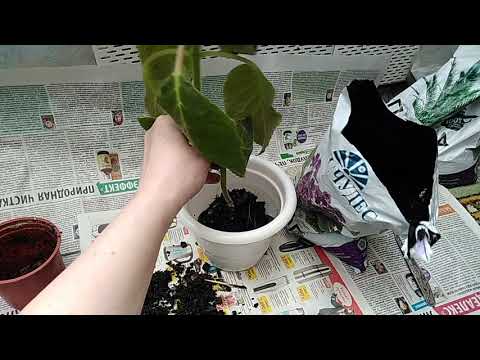

Watch this video on YouTube
Reproduction methods
Coleria from seeds
Sowing of coleria seeds is carried out in the second half of winter. For sowing, bowls are used, the seeds are evenly distributed over the surface of the substrate, but at the same time it is not necessary to cover them with a layer of earth on top. A soil mixture suitable for sowing should include 1 part of leafy soil and 2 parts of sand. After the sowing of the koleria is completed, the soil mixture should be poured through a strainer, and the container is covered with glass on top. The crops must be provided with daily ventilation, and they must also be placed in a warm place (from 20 to 24 degrees). After the seedlings appear, the shelter is removed, and the plants dive into a larger container, while using the same soil mixture as for sowing (see above). When diving, a distance of about 20 mm is observed between the shoots. After 4–6 weeks, the mature plants dive again, for this they are transferred into a new container, keeping a distance of 30 mm between the seedlings. In separate pots, reaching 70 mm in diameter, koleriya is planted only when the bushes develop well, while using a soil mixture consisting of light turf, peat and deciduous soil, as well as sand (1: 2: 4: 2).
Reproduction of coleria by cuttings
This plant can also be propagated by cuttings, for this you need to cut off the upper part of the shoot. For rooting, the cuttings are planted in a mixture consisting of sand and leafy earth, taken in equal parts, and you can also use just sand for this. The substrate is moistened, and then the container is covered with glass on top. It should be remembered that too high humidity can cause rot on the cuttings. To speed up the rooting process, cuttings are treated with an agent that stimulates root growth before planting, and you will also need a bottom heating of the container. The rooting process takes about half a month. Rooted cuttings need to be transplanted into separate pots, using the same substrate as for planting adult specimens (see above).
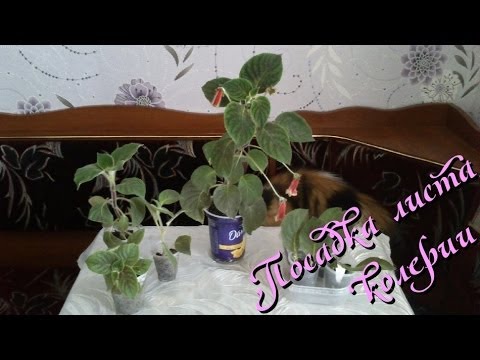

Watch this video on YouTube
Diseases and pests of koleria
Brown specks on foliage... In order to prevent the appearance of brown spots on the leaf plates, it is necessary to use not cold, but slightly lukewarm water for watering the bush.
Coleria leaves turn pale... If direct sunlight falls on the foliage or the bush is excessively overfed, then the surface of the leaf plates becomes faded and yellow spots form on it.
A gray bloom appeared on the foliage... If a gray bloom forms on the leaf plates, then this is a sign that the bush is affected by a fungal disease. This can happen due to excessively high air humidity and stagnant water in the soil mixture.
Twisting the foliage... Leaf plates can curl due to the fact that the plant lacks moisture. To increase the level of humidity in the air, it should be sprayed from a sprayer around the bush using lukewarm water. In this case, care must be taken that liquid does not fall on the surface of the sheet plates.
Coleria does not bloom... Sometimes flowering may be absent altogether or be extremely scarce, while there are several reasons:
- regular stagnation of water in the substrate;
- during the rest period, the air temperature in the room was either too high or too low;
- the bush lacks light;
- excessively low air humidity.
Coleria leaves wither.If in winter the bush feels a lack of light, then its foliage may wither a little.
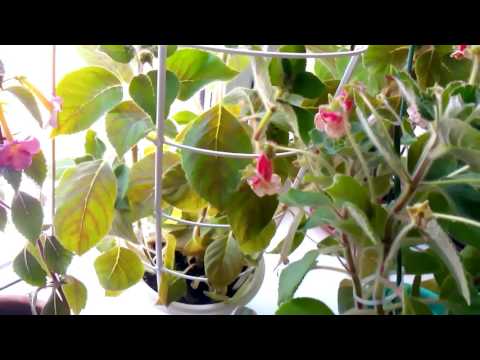

Watch this video on YouTube
Pests of koleria
Most often they settle on such a flower thrips, scabbards, whitefly, mealybugs and spider mites.
Types and varieties of koleria with photos and names
Koleria bogotka (Kohleria bogotensis)
Such a herbaceous perennial naturally occurs in Colombian forests, while it prefers to grow on rocky ground. The height of the bush is about 0.6 m. On the surface of non-branching straight shoots there is pubescence, consisting of white or red hairs. The shape of the pointed foliage is oval-heart-shaped or wide ovate, it reaches about 75 mm in length and up to 35 mm in width, the edge is jagged. The facial surface of the leaf plate is dark green, it has pubescence, located along the veins and consisting of variegated white hairs. The length of the pubescent pedicels is about 50 mm, they grow 1–2 flowers, which are axillary and drooping. The corolla tube is about 25 mm long, pubescent and pale red outside, and orange-red downwards. On the inner surface of the yellow throat there are specks and stripes of red. Lush bloom, it begins in the second half of the summer and lasts until the first weeks of autumn.
Coleria majestic (Kohleria magnifica)
There are red hairs on the surface of the stem. The leaf plates look quilted, they are glossy, and on their surface there is a pubescence, consisting of white hairs. Large orange-red flowers have dark streaks that go right into the pharynx.
Hairy coleria (Kohleria hirsuta)
The foliage is bronze. The outer surface of the tubular flowers has a red color, on the surface of the yellow throat there are rich red specks.
Coleria spikelet (Kohleria spicata)
The homeland of this species is Mexico. The bush is very small, the leaf plates adorning it have an elongated shape. At the apex of the long stems are red flowers, the throat of which is orange.
Coleria Linden (Kohleria lindeniana)
Under natural conditions, this species is found in the mountainous regions of Ecuador. The height of this herbaceous perennial is about 0.3 m, on the surface of the bush there is pubescence, consisting of white hairs. The length of the ovoid leaf plates is about 70 mm, and the width is up to 20 mm. The lower part of the green leaves has a pale pink tint; greenish or silvery-white veins are clearly visible on the dark green front surface of the plate. One or several axillary flowers are formed on peduncles, the length of which is about 60 mm. The corolla has a bell-shaped shape; the length of the flower petals and the corolla tube does not exceed 10 mm. On the surface of the tube there is a pubescence of white hairs, its inner surface is yellow with brown specks at the pharynx, and purple stripes are present on the white outer surface on the limbs. Lush bloom is observed in the first half of the autumn period.
Foxglove coleria (Kohleria digitaliflora)
In nature, such a herbaceous perennial is most often found in the forests of Colombia. On the surface there is a dense pubescence of white hairs, the stems are straight. The shape of the leaf plates is elliptical (lanceolate or ovoid), their length is from 18 to 20 centimeters, and their width is from 10 to 12 centimeters. On the surface of short petiolate green leaf plates there is a pubescence of hairs, while on the seamy surface it is more dense than on the front. Up to five flowers grow on axillary inflorescences. The length of the corolla tube is about 30 mm, it is white, and in the upper part with a pinkish tint. There are purple dots on the surface of the green throat of the corolla. The bush blooms most magnificently in the last summer and in the first autumn weeks.
Coleria uneven (Kohleria inaequalis)
A medium-sized bush has not very large pubescence. Orange-red flowers, their limb lobes are reddish, and there are dark dots on their surface.
Coleria pleasant (Kohleria amabilis)
Such herbaceous perennials in nature are most often found in the mountains of Colombia at an altitude of 800 m above sea level. On the surface of green or red stems there is pubescence of white hairs, their length is about 0.6 m. The length of the petioles is about 25 mm. Opposite ovoid leaf plates are up to 100 mm long and about 70 mm wide. The front surface of the foliage is dark green or green, and the back is greenish, there are silvery-white lines and brownish-red veins on the plate. On the outer surface of the axillary flowers there is pubescence, the corolla tube is pink - with white or white with purple spots at the pharynx. Flowering lasts almost all year round.
Coleria fluffy (Kohleria eriantha)
Velvety dark colored leaf plates have a red edge. The color of the pubescent large flowers is orange-red, on the surface of the lower lobe of the limb there are many yellow specks.
Coleria tube-flowered (Kohleria tubiflora)
It occurs naturally in Costa Rica and Colombia. The height of the bush is about 0.6 m. The lower surface of oval long leaf plates is red, and the upper one is dark green. The length of the red and orange flowers is about 25 mm.
Woolen koleria (Kohleria lanata)
The homeland of this kind is Mexico. The shoots are powerful. Small oval leaf plates, crenate along the edge, have dense pubescence of fawn hairs. On the surface of the orange-red corolla tube, there are dots of a pale crimson color, they cover the lobes of the wide-open limb. The bush looks fluffy due to the fact that small hairs grow on its entire surface.
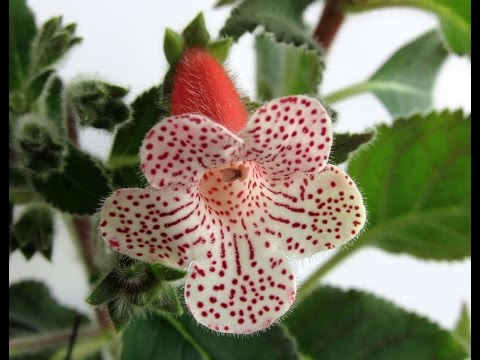

Watch this video on YouTube

